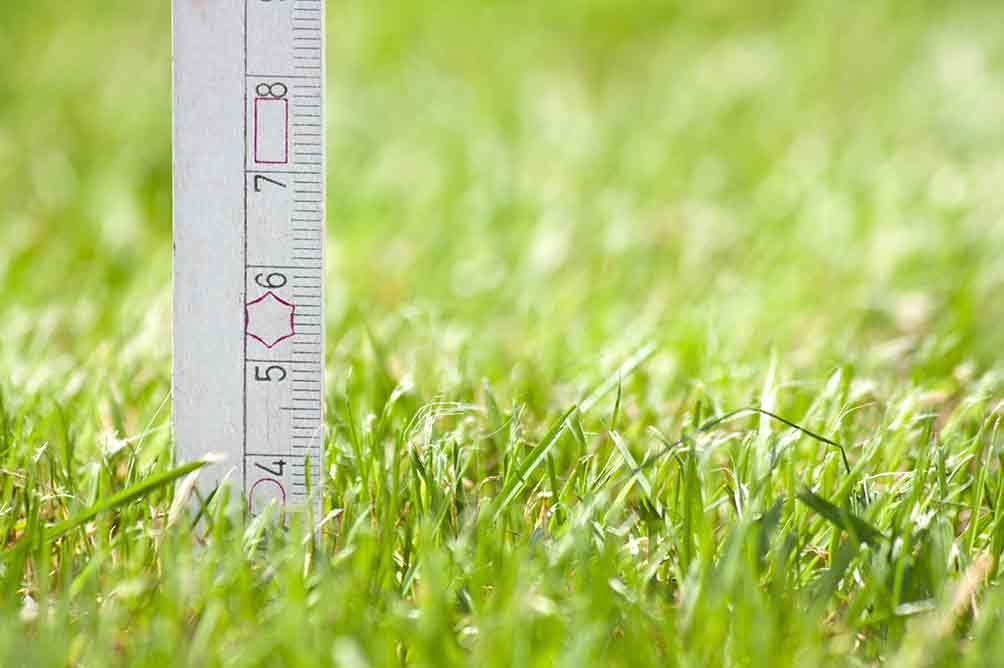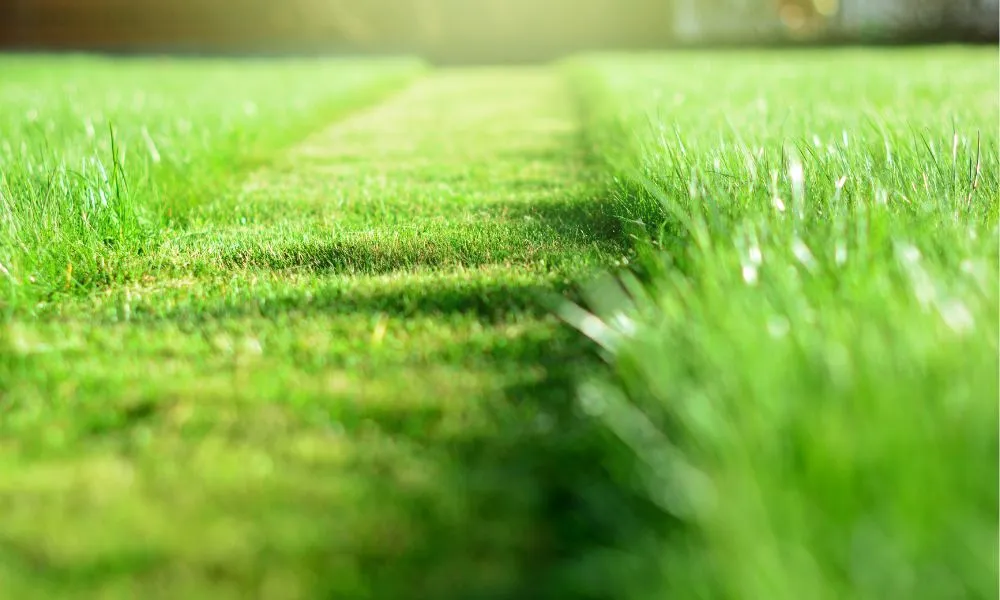Understanding The Importance Of Grass Height
It’s easy to overlook something as simple as mowing height when it comes to lawn health. Most homeowners assume that as long as the grass looks trimmed and tidy, it doesn’t matter how short or tall it is. But every adjustment you make to grass height influences how it breathes, how deeply it roots, how well it withstands heat, and how aggressively it fights off weeds and disease.
Grass height determines how much leaf blade the plant has available for photosynthesis, which directly fuels root growth and nutrient intake from fertilizers. When managed carefully, mowing height becomes a simple tool for keeping a lawn full and healthy! Keep reading to learn more!
When Grass Is Cut Too Short

Mowing too short (sometimes called “scalping”) is a common mistake that slowly starves turf. When blades are trimmed below a healthy range, the grass loses more of its energy-producing surface area than it can safely afford. Instead of capturing sunlight and delivering it to the roots, the plant is forced to deplete its stored carbohydrates to quickly rebuild leaf tissue. Over time, the roots grow shallower, leaving the lawn vulnerable to drought stress and heat damage.
Cutting grass too short also exposes soil directly to sunlight. This raises temperatures at the surface, dries the soil more rapidly, and creates favorable conditions for weeds like crabgrass to sneak in. Thin, scalped turf also suffers from bare spots, which make it easier for pests and lawn fungi to gain a foothold. Homeowners who routinely mow at low settings also see more frequent browning after hot days because the grass lacks enough tissue to shade its own crown.
Common problems caused by mowing too short include:
- Shallow root systems that struggle in summer weather
- Increased soil evaporation and heat stress
- Thin turf that allows weeds to establish
- Higher disease and insect vulnerability
- Bare patches that require overseeding and repair
When Grass Is Allowed to Grow Too Tall

On the other end of the spectrum, letting grass grow too tall poses its own set of complications. As the lawn stretches beyond its ideal height, the canopy becomes dense at the top and shaded near the base. That trapped moisture and poor air movement create the perfect humid environment for molds, fungi, and thatch development. When long blades begin to bend and mat together, the turf becomes patchy and uneven, making a single cut more stressful on the plant.
Extremely tall grass also exhausts a mower. Blades tear rather than cut cleanly, shredding leaf tips and leaving the turf with a grayish cast until recovery occurs. Grass left tall for long periods tends to produce unsightly seedheads, giving a rough, weedy appearance even when the lawn is otherwise healthy.
Suddenly lowering a tall lawn back into the recommended range is harmful. Removing too much leaf mass at once shocks the plant, removing its short-term energy source and causing lasting stress.
Typical issues found in overgrown turf include:
- Damp, shaded bases that encourage fungus
- Matted areas that stunt new growth
- Ragged cut tips caused by overworked mower blades
- Increased thatch accumulation over time
- Weeds taking advantage of thin lower growth
How Grass Height Influences Stress, Weeds, & Water

Taller turf shades the soil surface, slowing water loss, stabilizing temperature, and protecting the crown from scorching sunlight. For cool-season lawns in Omaha, letting the grass grow slightly higher during peak summer heat dramatically improves survival. The deeper roots that develop under taller mowing heights also allow grass to access moisture farther down, reducing watering demands.
Height also plays a strategic role in weed suppression. Weed seeds need sunlight to germinate. A thicker, taller canopy blocks light from reaching the soil, making it harder for unwanted species to sprout. Many professional lawn care providers favor higher mowing heights for this reason. However, in heavily shaded turf areas, lowering the height slightly can sometimes improve light penetration. Managing height is about balance, not rigidity.
Recommended Mowing Heights for Common Omaha Grass Types

Different grasses thrive at different heights due to their structure, growth habits, and seasonal patterns. Keeping a lawn at the wrong height for its species works against its natural strengths. Below are typical height ranges for the most common grasses found in Omaha lawns.
Kentucky Bluegrass: 2.5 to 3.5 inches
Kentucky bluegrass is a staple cool-season turf throughout Nebraska. It performs best with a medium height that protects its crown and encourages its characteristic dense, leafy growth. Many homeowners notice improved drought tolerance when this grass creeps toward the upper end during mid-summer. As autumn approaches, slightly lowering the height can reduce the risk of winter matting and snow-related fungal activity.
Tall Fescue: 3 to 4 inches
Tall fescue naturally grows upright with coarse blades and deep roots. Because of its root system, it tolerates summer stress well and benefits from a taller cut. Height helps it conserve moisture and maintain a cooler canopy above the soil. Homeowners who prefer lower-maintenance lawns often favor tall fescue because it stays greener with fewer inputs when kept at the correct height.
Perennial Ryegrass: 2 to 3 inches
Perennial ryegrasses establish quickly and are frequently used in blends. They respond best when kept slightly shorter than bluegrass, though still safely above scalping range. If ryegrass is allowed to grow too tall, it develops noticeable seedheads that create a coarse look. Conversely, cutting it too short quickly exposes thinning and stress.
Zoysiagrass: 1 to 2 inches
Though less common in the region, zoysia appears in some transition-zone lawns. Warm weather allows it to thrive at lower heights, creating a tight, carpet-like turf. In shaded areas, mowing height can be raised slightly to reduce thinning. Zoysia grows slowly, so maintaining its preferred height is easier than many think.
Proper Mowing Practices

Regardless of species, there’s a universal principle: never remove more than one-third of the grass blade in a single mowing. This prevents sudden depletion of the plant’s energy reserves. If a lawn gets out of control, raise the deck and gradually lower it over multiple sessions. Slow, steady correction promotes healthier recovery.
To get the most out of the correct height:
- Sharpen mower blades at least once per season
- Mow frequently enough to avoid drastic cuts
- Avoid mowing when grass is wet to reduce tearing
- Alternate mowing directions to prevent grain patterns
- Leave clippings when possible (they return nutrients to the soil)
Get Professional Help With Your Lawn
Grass height matters far more than most homeowners realize. From mowing to fertilizing, everything you do in your lawn care routine affects grass growth, so it is important to ensure you are taking care of your lawn the right way. If you want to ensure that your turf gets the best care for healthy growth all year long, call Summit today for expert lawn care services in Omaha!
